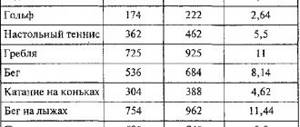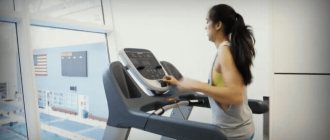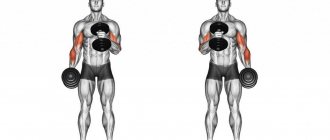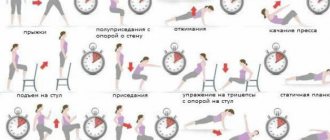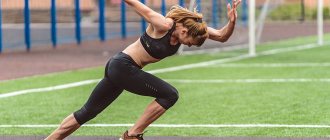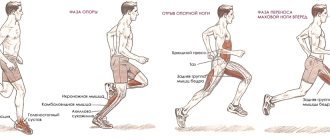Sports doctors and scientists are convinced that the human body’s ability to increase speed has finally reached its limit, and new records are only possible with the use of prohibited drugs. Not everyone, however, agrees with this conclusion. Who is right? And what running speed does a person need?
Factors influencing a person's speed performance
Running speed is an integral component in the training and competitive activities of an athlete. But even in everyday life, the opportunity to use your speed qualities is by no means superfluous.
A person’s speed performance depends on the following factors:
- level of preparedness;
- step length;
- pace;
- distance.
Maximum performance is typical for sprint distances. At long and medium distances they are significantly lower, and the main emphasis is on evenly distributing the load. Calm, leisurely health-improving running brings maximum benefit to the body.
Human running speed
Average
The average speed for an adult is 16-24 km/h. But the difference in performance between someone who just exercises regularly and a highly trained athlete will be different at different distances, for example:
- 36-39 km/h – 60-400 m;
- 18-23 km/h – 800-3000 m;
- 12-23 km/h - 5000-30000 m.
Thus, it is the result that needs to be achieved that is dominant.
Maximum
A person develops a maximum speed of 36-44 km/h over a short distance. To achieve it, you need frequent contact of the foot with the support while shortening the flight phase, correct tilt of the body and coordination of movements.
There are factors that determine the biological limit to maximum speed:
- the force of the foot striking the surface;
- time of foot contact with the ground;
- speed of muscle fiber contraction;
- oxygen deficiency.
How quickly the muscle fibers contract sets the limit on how fast the pushing force can be applied to the running surface.
Scientists suggest that with maximum contraction of muscle fibers, a person will be able to reach 65 km/h. However, achieving such an indicator will entail an acute lack of oxygen and very strong physical activity.
Record
Since the maximum speed was recorded in 1912 at the Stockholm Olympics (Donald Lippincott - 10.6 s), it has increased by only 1.02 s. The record currently belongs to Jamaican sprinter Usain Bolt – 44.72 km/h.
This figure was achieved in 2009 at the World Championships in Berlin in the 100 m race, which he covered in 9.58 s. Usain Bolt is also a record holder in the two hundred meters - 19.19 seconds. (2009) And at a distance of 400 m the record holder is Weide van Niekerk - 43.03 seconds. (2016)
The benefits of running for women
So, running, benefits and harm for women are on the agenda - and let’s start, as mentioned above, with the pros:
- Regular jogging greatly improves the psychological and physical health of women;
- Exercises allow you to maintain good physical shape - paired with proper nutrition, they will not allow you to gain weight, and will even help you lose weight;
- The individual benefit of running for a woman’s body lies in its effect on the reproductive system due to improved blood circulation and increased oxygen supply to cells;
- Due to the flow of oxygen, the condition of the skin and hair improves;
- Your mood improves, stress goes away, a joyful sparkle appears in your eyes;
- Brain function improves and the immune system improves.
The pros and cons of running for women are not at all equal in number - there are many more of the former. Now, as promised, we will tell you in what cases jogging can harm your health:
If you do not exercise regularly and have not become familiar with the correct running technique; If you go for a run while sick, even a mild ARVI is grounds for postponing the workout; Running in winter is contraindicated at temperatures below minus 15-20 degrees and winds stronger than 10 m/s; In winter, special attention is paid to choosing the right sports equipment, which will not allow the runner to sweat and get sick; If you have not bought good running sneakers (winter ones for the snowy season), the risk of injury increases; If you are breathing incorrectly. Correct breathing technique: you need to inhale through your nose and exhale through your mouth; Unless you do a pre-warm-up to warm up your muscles before sprinting.
Speed indicators at certain distances
In training, athletes usually perform only 70% of their maximum speed capabilities. The average performance of a professional athlete is as follows:
- 30 km/h - 60-400 m;
- 20 km/h - 800-3000 m;
- 16 km/h - 5000-30000 m.
What speed does a sprinter reach?
Sprint running is the fastest and most difficult of all types of running. The human body works at the limit of its capabilities and with a lack of oxygen. A sprinter must have excellent coordination, high endurance and perfect running technique.
The first record was recorded in 1912, and the main milestones are as follows:
- 10.6 sec. – American sprinter Donald Lippincott at the 1912 Olympics in Stockholm;
- 9.95 sec. - American athlete Jim Hines ran 100 m in less than 10 seconds at the Olympics in Mexico City in 1968;
- 9.58 sec. – the modern 100 m record was set in 2009 by Jamaican athlete Usain Bolt.
Speed performance at medium and long distances
Middle distance running - 800-3000 m - unlike long distance running, it is faster and shorter in duration. In this event, the main thing is to choose the optimal speed, using different running techniques at each stage of the distance, saving strength for the finishing spurt.
At long distances - 5000-30000 m and in marathon running, the main factor for success is endurance. Forces should be distributed evenly over the distance, taking into account the reserve of strength for the finishing spurt.
The speed of movement of an experienced and a beginner runner will be different:
- 20 km/h – at medium distances;
- 16-17 km/h – for a trained athlete over long distances.
Interval running principles and rules
This is a fairly common type of running, which is used as a way of sports training and weight loss. Its key principle is periodic alternation of walking and running. This helps you relax after maximum stress, restore the body’s resources, and start exercising again. The technique of running for weight loss is also simple, but has clear instructions on how to run correctly.
The best option for interval running is the following alternation:
- 100 m – walking;
- 100 m – sprint;
- 100 m – jogging.
The load is added gradually. The workout begins with walking for 15 minutes. Then the transition to running takes place. After the sprint, there is no sudden stop - the load continues in the form of light jogging.
The following alternation of stages can be considered correct in the interval running technique: one lap of walking - one lap of sprinting - one lap of jogging - two laps of sprinting - one lap of jogging - one lap of walking. After completing such a cycle, it can be repeated. The number of interval running cycles completed depends on the location of training and the size of the distance.
Interval running burns significantly more calories than regular running. At the acceleration stage, energy consumption doubles. The greatest energy release occurs during sprinting. At this stage, the largest amount of fat deposits is broken down.
During the deceleration and load reduction stage, energy consumption does not stop. After such a run, the body continues to burn calories for another six hours.
The optimal frequency of training using interval running is 2-3 times a week. On other days, you can use steady running.
Running is an effective way to lose excess weight in a relatively short time. There is a variety of choices among types of running. In order for each of them to achieve the desired results, you must first of all adhere to the key rules and running techniques.
Health running technique
By performing our professional duties efficiently, we not only increase the trust of management, but also make the work more productive and useful. Also in running. When practicing recreational running, achieving results depends not only on desire and determination, but also on technique.
How will mastering technology help?
Even a slight improvement in technique guarantees that you cover a longer distance, the pace is higher than usual, and as a result, the effect of the lesson becomes more pleasant and soon noticeable.
Basic elements of technology that will help improve the result:
- When running, the torso is held straight or slightly tilted forward (5-7 degrees)
- The shoulder girdle is lowered and relaxed. Shoulder tension causes muscles to needlessly fatigue, since this muscle group should not be actively working when running.
- hands work freely. Try to focus minimal attention on the movement of your hands. However, it is important that they work. Otherwise, rotation of the body occurs, which leads to a violation of the integrity of the technique.
- The foot is placed 20-25 cm from the general center of gravity. In other words, 1 running step is equal to approximately 50 centimeters. This indicator depends on the selected running pace.
The duration and speed of the run are determined depending on the level of training and the assigned tasks.
Experience shows that mastering the technique allows you to improve your results immediately. Tested on someone I know. This was our second run together. The first was not successful, the partner survived about 1000 meters and was incredibly tired. During the second run, I decided to help and gave practical recommendations directly during the run. As a result, the distance increased to 3000 meters. The next training session showed that mastering the technique helped to run segments with a slight change in speed (4 repetitions of 400 meters).
Training planning
The first thing you need to do is warm up. Its absence is bad for your joints and can lead to serious problems over time. Therefore, be sure to devote 7-10 minutes to preliminary exercises. For example:
- tilting the body to the sides;
- rotation of the body - describe a wide circle with your hips, repeat in the other direction;
- circular movements in the knee joints - performed alternately in different directions.
You can create different warm-up options yourself. The main thing is for the body to start working, to warm up the joints and muscles.
It is important to monitor your breathing. At the right pace, the athlete can talk while running
It is better to inhale through the mouth, exhale through the nose. The pulse should not rise above 120 beats per minute. If this happens, you need to slow down the pace, take a step, but you should not make an abrupt stop. To monitor your heart rate, you can purchase a heart rate monitor.
It is advisable for both men and women to start with 10 minutes. running, alternated with fast walking. Three lessons per week are enough. Gradually, the duration of the run is increased to 40–60 minutes. You shouldn’t train for more than an hour and a half - it’s better to gradually increase the load by making the distance more difficult.
The recommended time to start training varies: men can go for a run at any hour; in women, the production of necessary hormones increases at the end of the day. But you shouldn’t run too late, or your body won’t have time to fully rest.
It is better not to eat before your morning workout. It is acceptable to drink coffee without sugar or an isotonic drink (however, this is not recommended for those trying to lose weight). Before a day's jogging, it is advisable to have a light carbohydrate snack that will not weigh down your stomach. It could be a special sports shake, a banana or an apple.
The benefits of health running
The ability to freely change the degree of load, as well as the nature of the workout, is a distinctive feature of running. High variability allows people of any age, physical development and previous injury to perform the exercise. With a dosed load, the body's recovery occurs much faster, since tissues and organs receive a sufficient amount of building material (protein) for recovery.
A feature of running is the harmonious development of tissues and organs, as well as the nervous system. While jogging, the cardiovascular system is trained; regular running training leads to an increase in heart volume and a reduction in heart rate. This allows the heart muscle to work in a simpler mode.
Athletes involved in cyclic sports have a heart rate of 38-40 beats per minute over an extended period. This is an indicator of a highly developed cardiovascular system. Normally, for an ordinary person, this figure ranges from 60 to 90 beats. An exception may be the presence of bradycardia - the course of the disease is characterized by a low heart rate (less than 55 beats).
From the author: The number of heart contractions at rest ranges from 48 to 54 beats per minute.
The most common goals of health running are:
- Health promotion
- Correction of physique defects (weight loss)
- Increasing the body's capabilities (endurance)
- Developing a habit of exercise
- Education of moral-volitional qualities (the ability to endure with a high degree of fatigue)
An additional incentive for jogging can be the fact that the high development of moral and volitional qualities is reflected in professional performance. As a result, the supply of vital energy increases and the strength lasts for a longer period.
